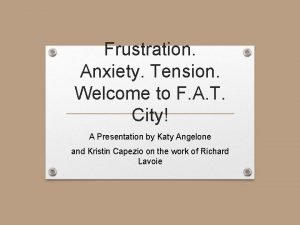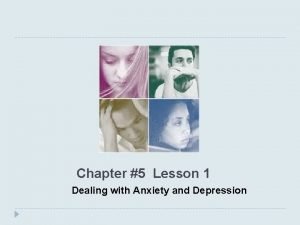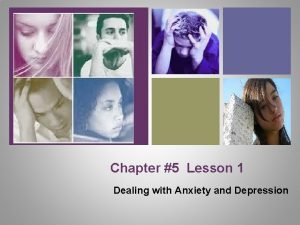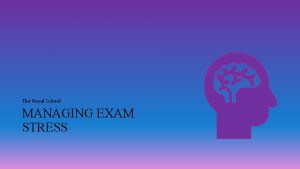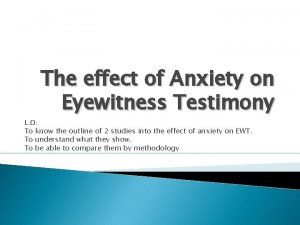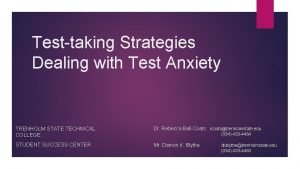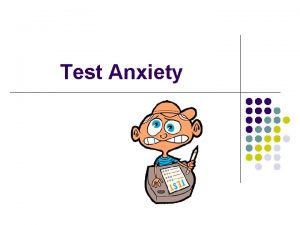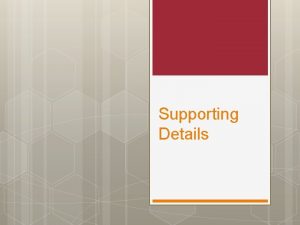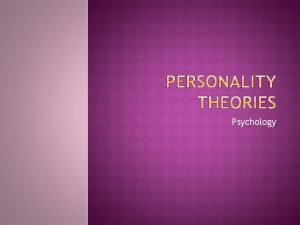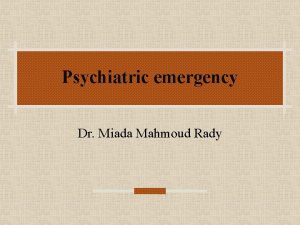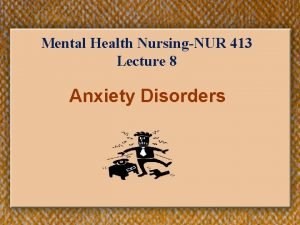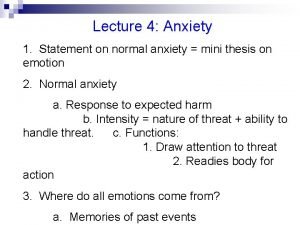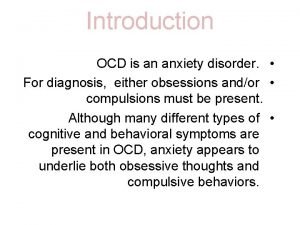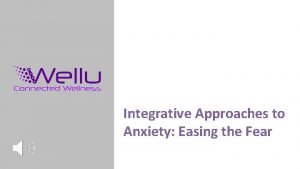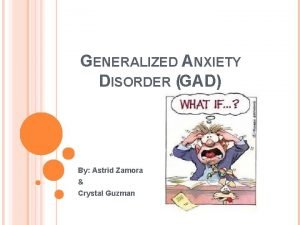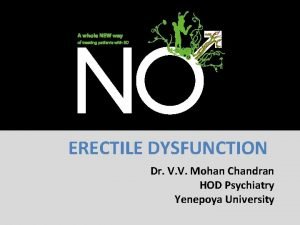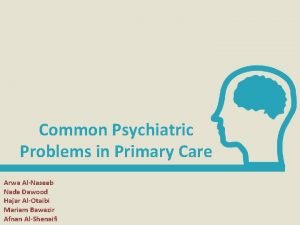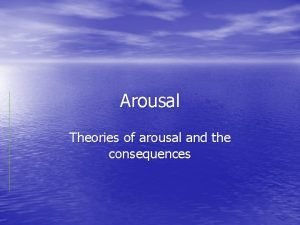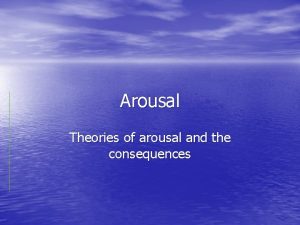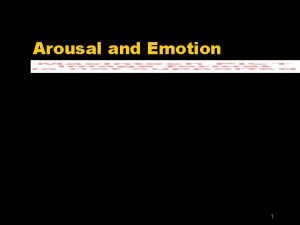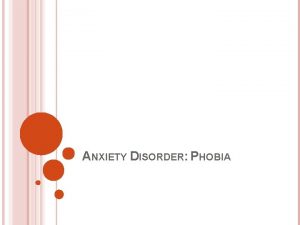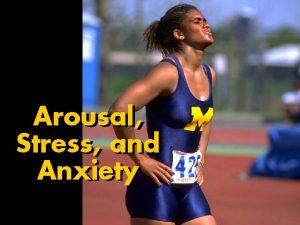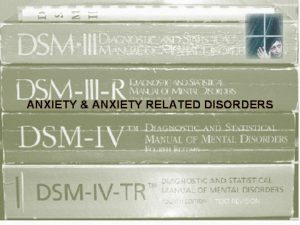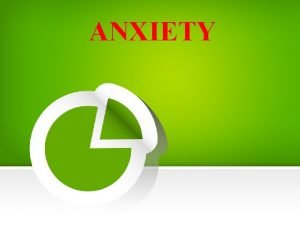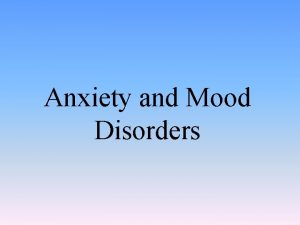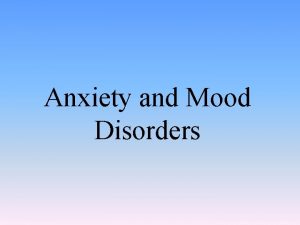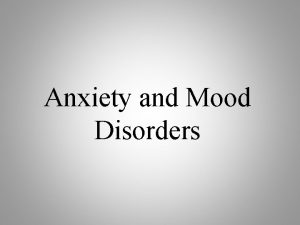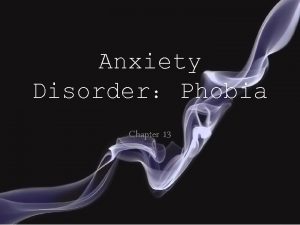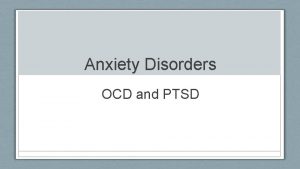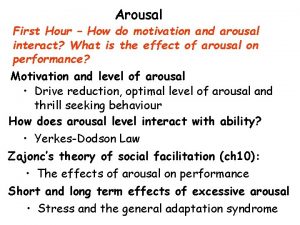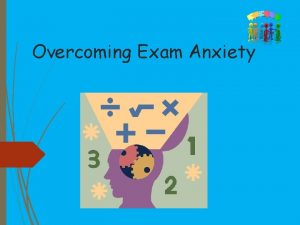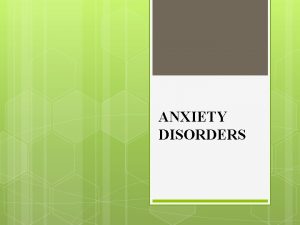Anxiety and Arousal Arousal is a state of





















- Slides: 21

Anxiety and Arousal

Arousal is a state of mental and physical preparedness for action (Davis, Bull, Roscoe & Roscoe, 2000)

Continuum Our arousal levels range from deep sleep to intense excitement. During the day our level fluctuates depending on the situation we are in.

The relationship between arousal and performance can be complicated. While one person may be ‘psyched up’ for the challenge of competition another ‘chokes’ and performs far below expectations. As a sports athlete you need to learn to control arousal. You should be able to increase arousal when feeling lethargic and decrease it when the pressure causes nervousness and anxiety. It is the better athletes who are able to control arousal when they perform in anxiety provoking games.

Symptoms Physical (physiological) – fluctuations in heart rate, sweating, breathing, butterflies in the stomach. Cognitive (psychological) – fluctuations in concentration, worry and effective decision making.

Arousal and Performance Drive Theory states that as arousal increases so does the dominant habit. Tip: think of a ‘closed skill’ e. g. A tennis serve. If you have learnt that skill so it is very stable and enduring (long lasting) then in high pressure situations e. g. serving for the championship you will be able to serve very well. However if you have not learnt how to serve very well then the pressure will have an even more adverse effect on your serve.

DRIVE THEORY Dominant Habit Arousal

Inverted U Theory The Drive Theory does not explain why some sporting performances improve and some decline in different circumstances. The Inverted U Theory states that arousal must be at an ‘optimal level’ for peak performance. If arousal is too low then the athlete must ‘psych’ themselves up and if arousal becomes too high it turns to ANXIETY.

Inverted U Theory High Performance Low Optimal Arousal

Individual Differences Many theorists believe the Inverted U Theory is too simplistic and therefore we all have a different ‘optimal’ level of arousal. This level will change depending on the task (simple or complex), the personality of the athlete (introvert or extrovert) and the stage of learning (cognitive or autonomous)

Anxiety is an emotional state, similar to fear, associated with physiological and psychological arousal and with feeling of nervousness and apprehension. Davis, Bull, Roscoe & Roscoe, 2000

Task 3 pupils of varying personality come to the front of the class please! You will be competing for the grand prize of £ 1! Class - your job is to create an intense, electric sporting arena for them to compete in! Who are you cheering on?

Task The competition can vary depending on the facilities available, § Basketball free throw § Golf putting § Left handed target throwing § Football keep ups § Hockey penalties

Discuss Interview the contestants in a ‘Match of the Day’ style! 1. How did you feel competing in front of the rest of the class? 2. Are you generally a nervous person in most situations? 3. Physiological symptoms? 4. Psychological symptoms?

Key Terms Using the quotes in the interview and the definitions in your text books, provide examples of the following; STATE ANXIETY, TRAIT ANXIETY, COGNITIVE ANXIETY, SOMATIC ANXIETY

Happens to the best of us! Professional sport is highly competitive and as a result produces huge amounts of pressure for the athlete. This pressure can cause anxiety and have dramatic effects on performance – even professional sportsmen! Jean Van de Velde was 3 shots in the lead standing on the last tee of the British Golf Open and poised to win his first ‘major’. http: //www. youtube. com/watch? v=1 d. R 1 pk. CGY 80

SCAT Test Martens (1977) developed the Sport Competition Anxiety Test (SCAT) This measures your level of anxiety in a sporting situation. Have a go http: //www. brianmac. co. uk/scatform. pdf

Task Research other sporting examples where pressure has seemed to have a negative impact on the athletes sporting performance. What reasons did they provide in post match interviews? Could you see any physiology symptoms during the performance?

Exam Question With reference to sporting performance, explain how cognitive and somatic anxiety differ. (Total 5 marks)

Exam Answers Must use sporting example Max 4 marks from: 1. Cognitive anxiety is psychological response/worry/inability to concentrate/loss of attention/fear of failure. 2. E. g. worry that tennis opponent is a much better player than you. 3. Somatic anxiety is a physiological response. 4. E. g. increased heart rate/adrenaline/‘butterflies’/sweaty palms before the tennis match begins. Max 2 marks from: 5. 6. 7. 8. Cognitive may remain high during performance. The more you worry, the bigger the drop in performance. Somatic should reduce once performance begins. Effects of somatic similar to inverted ‘U’.

References Davis, Bull, Roscoe & Roscoe (2000) Physical Education and the Study of Sport Martens (1977) Sport Competition Anxiety Test. Human Kinetics www. brianmac. co. uk www. youtube. com
 Stai adalah
Stai adalah Chapter 8 managing stress and anxiety
Chapter 8 managing stress and anxiety Frustration anxiety and tension
Frustration anxiety and tension Chapter 15 anxiety and obsessive-compulsive disorders
Chapter 15 anxiety and obsessive-compulsive disorders Chapter 5 lesson 1 dealing with anxiety and depression
Chapter 5 lesson 1 dealing with anxiety and depression Chapter 5 lesson 1 dealing with anxiety and depression
Chapter 5 lesson 1 dealing with anxiety and depression Staff fear and anxiety cpi
Staff fear and anxiety cpi Anxiety symptoms
Anxiety symptoms How anxiety affects eyewitness testimony
How anxiety affects eyewitness testimony Relaxation techniques test anxiety
Relaxation techniques test anxiety Anxiety symptoms
Anxiety symptoms I'm a perfect example of someone who has math anxiety
I'm a perfect example of someone who has math anxiety Neurotic behavior
Neurotic behavior Anxiety mnemonic
Anxiety mnemonic Nursing interventions for ineffective coping
Nursing interventions for ineffective coping Examples of generalized anxiety disorder
Examples of generalized anxiety disorder Free floating anxiety
Free floating anxiety Childhood ocd symptoms
Childhood ocd symptoms Uw integrative medicine
Uw integrative medicine Examples of generalized anxiety disorder
Examples of generalized anxiety disorder Mecbal
Mecbal Generalized anxiety disorder dsm 5
Generalized anxiety disorder dsm 5


